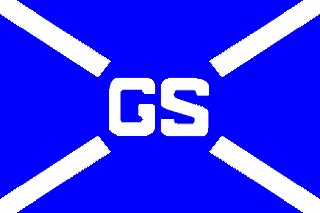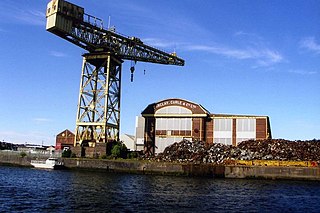
The Fairfield Titan was a giant cantilever crane at BAE Systems' Govan shipyard, and the largest such crane on the River Clyde until it was demolished in 2007. [1]

The Fairfield Titan was a giant cantilever crane at BAE Systems' Govan shipyard, and the largest such crane on the River Clyde until it was demolished in 2007. [1]
The crane was built by Sir William Arrol & Co. at the Fairfield Shipbuilding and Engineering Company yard in 1911, and was first used to install machinery in HMS New Zealand (1911) . [2] [3]
The Titan was last used six weeks before its demolition, assembling a Type 45 destroyer. [4] Despite being category A listed, permission was granted for its removal as it was hindering development of the yard, and it was dismantled over a period of three weeks and recycled. [4]
The crane features in the song Shipyard Apprentice by Scottish traditional music group Battlefield Band. [5] [6]
The original 200-tonne (220-short-ton) tested capacity was uprated to 250 t (280 short tons)c. 1941, and then later derated to 220 t (240 short tons). [7] Two 65-brake-horsepower (48-kilowatt) electric motors powered the main hoist, and a 95-brake-horsepower (71-kilowatt) motor actuated an auxiliary hoist to allow loads of up to 40 t (44 short tons) to be lifted at the maximum radius of 161 ft (49.1 m). [8]

A crane is a type of machine, generally equipped with a hoist rope, wire ropes or chains, and sheaves, that can be used both to lift and lower materials and to move them horizontally. It is mainly used for lifting heavy things and transporting them to other places. The device uses one or more simple machines to create mechanical advantage and thus move loads beyond the normal capability of a human. Cranes are commonly employed in transportation for the loading and unloading of freight, in construction for the movement of materials, and in manufacturing for the assembling of heavy equipment.

The Fairfield Shipbuilding and Engineering Company, Limited was a Scottish shipbuilding company in the Govan area on the Clyde in Glasgow. Fairfields, as it is often known, was a major warship builder, turning out many vessels for the Royal Navy and other navies through the First World War and the Second World War. It also built many transatlantic liners, including record-breaking ships for the Cunard Line and Canadian Pacific, such as the Blue Riband-winning sisters RMS Campania and RMS Lucania. At the other end of the scale, Fairfields built fast cross-channel mail steamers and ferries for locations around the world. These included ships for the Bosporus crossing in Istanbul and some of the early ships used by Thomas Cook for developing tourism on the River Nile.

Govan Shipbuilders Ltd (GSL) was a British shipbuilding company based on the River Clyde at Glasgow in Scotland. It operated the former Fairfield Shipyard and took its name from the Govan area in which it was located.

The Finnieston Crane or Stobcross Crane is a disused giant cantilever crane in the centre of Glasgow, Scotland. It is no longer operational, but is retained as a symbol of the city's engineering heritage. The crane was used for loading cargo, in particular steam locomotives, onto ships to be exported around the world.

John Brown and Company of Clydebank was a Scottish marine engineering and shipbuilding firm. It built many notable and world-famous ships including RMS Lusitania, RMS Aquitania, HMS Hood, HMS Repulse, RMS Queen Mary, RMS Queen Elizabeth and the Queen Elizabeth 2.
Lithgows Limited is a family-owned Scottish company that had a long involvement in shipbuilding, based in Kingston, Port Glasgow, on the River Clyde in Scotland. It has a continued involvement in marine resources.

Titan Clydebank, more commonly known as the Titan Crane is a 150-foot-high (46 m) cantilever crane at Clydebank, West Dunbartonshire, Scotland. It was designed to be used in the lifting of heavy equipment, such as engines and boilers, during the fitting-out of battleships and ocean liners at the John Brown & Company shipyard. It was also the world's first electrically powered cantilever crane, and the largest crane of its type at the time of its completion.
HMS E48 was a British E class submarine launched by Fairfield Shipbuilding and Engineering Company, Govan in 1916 and was completed by William Beardmore and Company, Dalmuir. She was launched on 2 August 1916 and was commissioned in February 1917.
HMS E47 was an E-class submarine launched by Fairfield, Govan for the Royal Navy and completed by William Beardmore, Dalmuir. She was launched on 29 May 1916 and was commissioned in October 1916.
HMS E37 was a British E class submarine built by Fairfield, Govan, Clyde. She was launched on 2 September 1915 and commissioned on 17 March 1916. E37 was lost in the North Sea on 1 December 1916. There were no survivors.
HMS E38 was a British E class submarine built by Fairfield, Govan, Clyde. She was launched on 13 June 1916 and commissioned on 10 July 1917. E38 was sold for scrap in Newport on 6 September 1922.

Sir William Arrol & Co. was a leading Scottish civil engineering and construction business founded by William Arrol and based in Glasgow. It built some of the most famous bridges in the United Kingdom including the second Tay Bridge, the Forth Bridge and Tower Bridge in London.
Kvaerner Govan Ltd (KGL), located at Govan in Glasgow on the River Clyde, was a shipyard subsidiary formed in 1988 when the Norwegian group Kværner Industrier purchased the Govan Shipbuilders division of the nationalised British Shipbuilders corporation. Prior to the Govan Shipyard's nationalisation in 1977, as a result of the Aircraft and Shipbuilding Industries Act, it had been operated by Govan Shipbuilders Ltd, which emerged from the collapse of the previous Upper Clyde Shipbuilders (UCS) joint venture in 1972. Prior to the formation of UCS in 1968, the Shipyard was operated by the Fairfield Shipbuilding and Engineering Company, which had a history extending back to 1834.

Titan was a floating crane that operated in Sydney Harbour from 1919 until 1991. She was fabricated in Carlisle in the United Kingdom, then sent to Cockatoo Island Dockyard in Sydney for assembly, before entering service with the Royal Australian Navy (RAN).

The Barclay Curle Crane is a disused Titan or giant cantilever crane at the Barclay Curle shipyard at Whiteinch, Glasgow, Scotland.

The James Watt Dock Crane is a giant cantilever crane situated at Greenock on the River Clyde.
The Beardmore Crane was a giant cantilever crane at the William Beardmore and Company yard.

Langer Heinrich, or in English Long Henry, is a floating crane commissioned in 1915 for the Wilhelmshaven Imperial Shipyard in Wilhelmshaven, Germany and has been located in Genoa, Italy since 1997. At the time of completion she was the largest floating crane in the world, passing up the Ajax crane barge completed in 1914.

A block-setting crane is a form of crane. They were used for installing the large stone blocks used to build breakwaters, moles and stone piers.

The Arrol Gantry was a large steel structure built by Sir William Arrol & Co. at the Harland and Wolff shipyard in Belfast, Northern Ireland. It was built to act as overhead cranes for the building of the three Olympic-class liners.
|journal= (help)